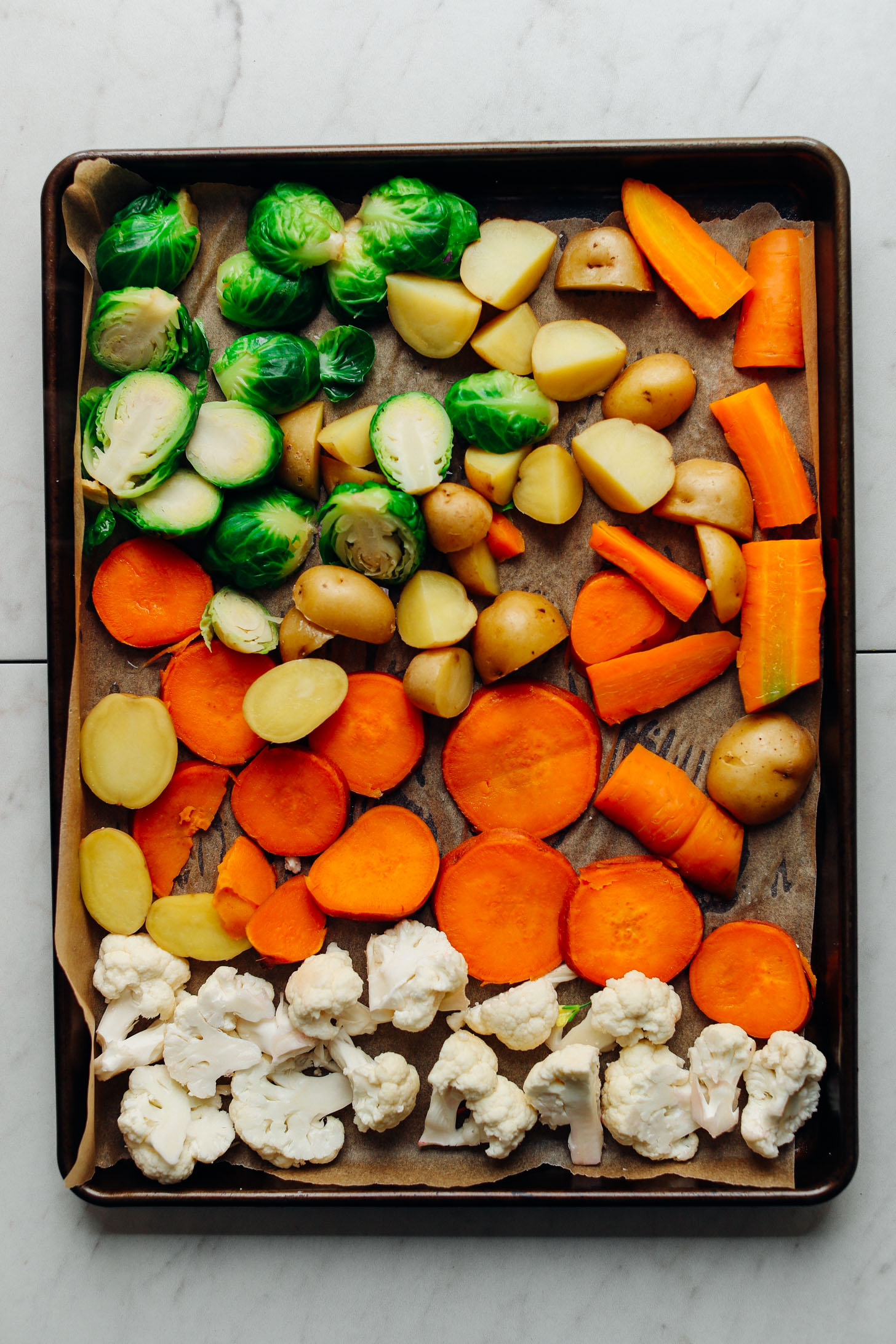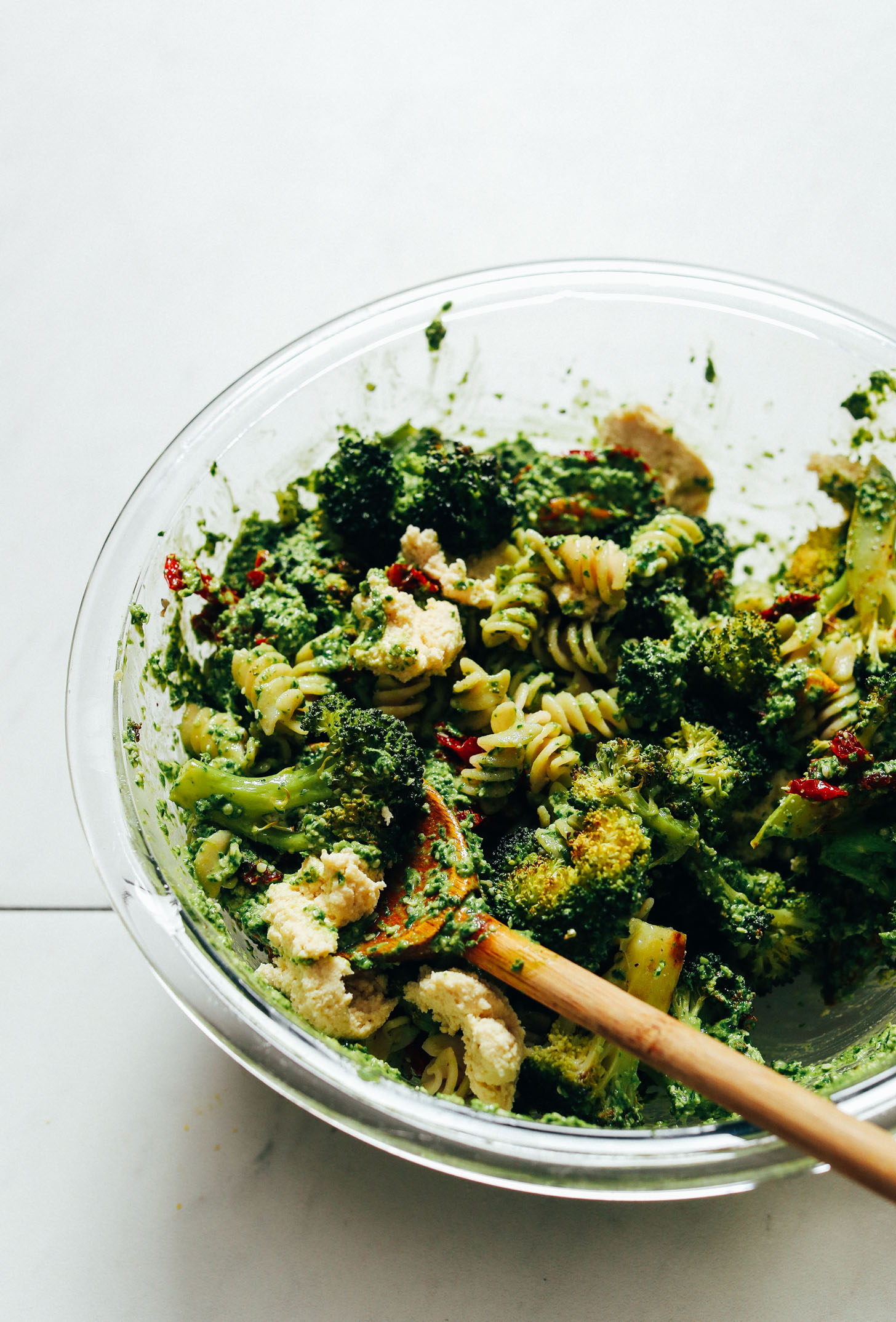How Long Do You Cook Roasted Vegetables

Hello friends! Consider this your step-by-step tutorial on how to roast vegetables (with and without oil)!
We believe roasting vegetables is a basic cooking skill that everyone should know. It's also easy to do year-round with whatever produce is in season. And it's a sneaky and proven way to convert veggie skeptics into veggie lovers.
Plus, did we mention it's EASY !?
Which Vegetables Can Be Roasted
Nearly any vegetable can be roasted, but we find that those that typically work best have a lower moisture content (such as sweet potatoes and carrots) or lots of flavor (such as onion, garlic, and cherry tomatoes).
A lower moisture content helps them develop a perfectly browned, caramelized exterior and those with lots of flavor become even more concentrated through the cooking process.
Here are some of our favorite roasted vegetables:
- Root vegetables (sweet potato, potato, butternut squash, carrots, beets, radish, onion, garlic, etc.)
- Cruciferous vegetables (broccoli, cauliflower, cabbage, Brussels sprouts)
- Others (asparagus, slow roasted tomatoes, zucchini, mushrooms)

Tips for Success
There are a few key tips to keep in mind for cooking perfectly roasted vegetables every time!
- Slice veggies evenly to ensure even cooking. If you don't mind some crunchier and crispier pieces, this is less important.
- Group veggies by cooking time– root vegetables generally take longer than cruciferous ones (40 minutes vs 25 minutes). Group on separate pans so that they finish baking at the same time.
- Avoid overcrowding the pan(s)– arrange the veggies on enough baking sheets to allow them to sit in a single layer. Crowding can cause them to cook unevenly and steam rather than roast (meaning less caramelization).
- Season appropriately– we love adding a heavy coating of curry powder and a generous pinch of salt. Fresh herbs are also delicious. But if you plan to freeze them for adding to smoothies (carrots, sweet potatoes, cauliflower, etc.), then it is best to only season with salt.
- The perfect temperature– 400 degrees Fahrenheit is the perfect temperature for most roasted vegetables. It allows for a crispy, perfectly browned exterior and a fork tender interior. But it will vary based on the types of veggies and oil used. If your veggies are not browning enough, try increasing the temperature. If they are browning before they are fully cooked, try reducing it.

How to Reheat Roasted Vegetables
Roasted vegetables are best served fresh, but are also delicious served cold the next day or reheated by a dry heat method (baking, broiling, grilling, sautéing or roasting).
To maintain the best texture when reheating, we recommend reheating roasted vegetables in a cast-iron skillet over medium heat or in a 375 degree Fahrenheit oven until hot.
Reheating them in the microwave is not ideal as they tend to become soggy.

How to Use Roasted Vegetables
Roasted vegetables can be enjoyed alongside a main dish (such as our Vegan Lentil Nut "Meatloaf") or creatively added to salads, dips, bowls, smoothies, soups, and more.
We have included 6 delicious and easy ways to put roasted vegetables to use so you can feed yourself and those you love!
- Kale Salad (similar to video)
- Pasta Salad (similar to video)
- Beet Hummus (similar to video)
- Grain Bowl (similar to video)
- Carrot Smoothie (similar to video)
- Soup (similar to video)
Check out the video to see these recipes in action!
If you try this recipe, let us know! Leave a comment, rate it, and don't forget to tag a photo #minimalistbaker on Instagram. Cheers, friends!
Prep Time 10 minutes
Cook Time 35 minutes
Total Time 45 minutes
Servings 8 (Servings)
Course Side Dish
Cuisine Gluten-Free, Vegan
Freezer Friendly 1 month
Does it keep? 4-5 Days
VEGETABLES
- 1 medium sweet potato (well rinsed, skin on, sliced into 1/4-inch rounds)
- 1 large beet (well rinsed, skin on, sliced into 1/4-inch rounds)
- 2 large carrots (well rinsed, peeling optional, thinly sliced on a slant)
- 1 bulb garlic (cloves removed and separated, peeling optional)
- 1 small red or white onion (skin removed, sliced into thin wedges from top to bottom)
- 1 small head cauliflower (cut into large bite-sizes pieces)
- 1 small head broccoli (cut into large bite-sizes pieces)
- Any other seasonal vegetables you have on hand (well rinsed, peeling optional, sliced in bite-size pieces)
- 1-2 Tbsp neutral oil (such as avocado or coconut // or try our Oil-Free Method! )
- Sea salt to taste
- Other seasonings as desired* (like our DIY Curry Powder!)
-
Preheat oven to 400 degrees F (204 C) and prepare 1-2 large baking sheets (depending on how many vegetables you're roasting) with parchment paper or a non-stick sheet.
-
Follow the tips above to prepare vegetables for roasting by rinsing as needed, peeling as desired, and slicing/piecing into bite-size pieces. Peeling the garlic is optional – it can be roasted peeled OR with the skin on.
-
Add vegetables to the same baking pans according to their required cook time. Root vegetables (beets, carrots, potatoes, etc.) generally tend to take longer (up to 40 minutes), so I like to group them together so they finish baking at the same time.
Cruciferous vegetables (like cauliflower, broccoli, and cabbage), as well as garlic and onion don't tend to require as much time to cook (~25 minutes) so we recommend grouping them together on a separate pan so they finish baking at the same time.
-
Once on the pan, drizzle with a little oil to coat (see this method for oil-free!), a pinch of salt, and desired seasonings of choice. We prefer a heavy coating of curry powder. NOTE: However, depending on how you intend to use the vegetables, you may choose not to season. For instance, if you plan to freeze your roasted carrots or sweet potatoes and then add them to smoothies, maybe just add a little salt and omit any further seasoning.
-
Rub the oil and seasonings of choice into the vegetables and arrange into even layers so there isn't much or any overlap. Then bake until golden brown and tender (anywhere from 20-30 minutes for cruciferous vegetables, onions, and garlic, and anywhere from 25-40 minutes for root vegetables).
-
Remove from oven and enjoy immediately on things like salads, bowls, in pasta salads and more! See the video below for inspiration. I like to freeze my roasted (or even steamed) carrots and sweet potatoes to add to smoothies throughout the week. My favorite way to use beets is blended into hummus. And roasted broccoli and cauliflower are perfect for grain bowls, pasta salads, and more.
-
Enjoy when fresh, or store leftovers covered in the refrigerator up to 4-5 days. Reheat in a cast-iron skillet over medium heat, or in a 375 degree F (190 C) oven until hot.
You can also freeze up to 1 month, but it's usually best to add these frozen roasted vegetables to things like smoothies, stews, and vegetable broth where their texture will be masked.
*Nutrition information is a rough estimate for 8 (1-cup) servings of vegetables with 1 Tbsp avocado oil and no salt or seasonings // make adjustments to nutrition information as needed when altering volume of ingredients).
Serving: 1 servings Calories: 87 Carbohydrates: 15.3 g Protein: 3.8 g Fat: 2.2 g Saturated Fat: 0.3 g Polyunsaturated Fat: 0.31 g Monounsaturated Fat: 1.23 g Trans Fat: 0 g Cholesterol: 0 mg Sodium: 66 mg Potassium: 520 mg Fiber: 4.2 g Sugar: 4.6 g Vitamin A: 5800 IU Vitamin C: 121.3 mg Calcium: 70 mg Iron: 1.1 mg
Reader Interactions
How Long Do You Cook Roasted Vegetables
Source: https://minimalistbaker.com/how-to-roast-vegetables/
Posted by: meiercambactint.blogspot.com

0 Response to "How Long Do You Cook Roasted Vegetables"
Post a Comment